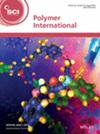求助PDF
{"title":"荧光聚二烯基二甲基铵离子磺化罗丹明染料配合物的表征及其与氯离子和羧酸离子的相互作用","authors":"Anna M Johnson, Frederick Jutton, Edward E Remsen","doi":"10.1002/pi.70002","DOIUrl":null,"url":null,"abstract":"<p>Aqueous mixtures of the poly(diallyldimethylammonium cation) (<i>p</i>DADMA<sup>+</sup>) and the fluorescent anionic dye Alexa Fluor® 546 (A546) are characterized using multiple fluorescence spectroscopy techniques. A546 and <i>p</i>DADMA<sup>+</sup> demonstrate binding interactions leading to the formation of noncovalent A546–<i>p</i>DADMA<sup>+</sup> complexes based on the quenching and recovery of A546 fluorescence emission intensity as a function of <i>p</i>DADMA<sup>+</sup> concentration. Fluorescence anisotropies of the mixtures support the results of fluorescence emission intensity analysis and yield a sub-micromolar equilibrium dissociation constant for the complexes indicating that strong attractive electrostatic interactions produce complexation. Fluorescence correlation spectroscopy (FCS) characterization of the complexes in solutions containing systematically varied concentrations of either chloride or carboxylate anions suggests chain dimension collapse of <i>p</i>DADMA<sup>+</sup> in the complexes and preferential binding of A546 anions to lower-molecular-weight complexes in solution. Comparison of these effects as a function of solution ionic strength produced by chloride, monocarboxylate and dicarboxylate anion addition indicates that carboxylate anions have significantly stronger binding interactions with <i>p</i>DADMA<sup>+</sup> than chloride ions. Differences in the binding of aliphatic carboxylate anions of different chain length with <i>p</i>DADMA<sup>+</sup> are attributed to differences in their hydrophobic interactions with the organic polymer chains of <i>p</i>DADMA<sup>+</sup>. Further FCS studies of noncovalent A546–<i>p</i>DADMA<sup>+</sup> complexes prepared from narrow-molecular-weight fractions of <i>p</i>DADMA<sup>+</sup> hold the promise of deeper insights into the binding behaviors and hydrodynamic size variability of this industrially important polyelectrolyte. © 2025 Society of Chemical Industry.</p>","PeriodicalId":20404,"journal":{"name":"Polymer International","volume":"74 11","pages":"981-989"},"PeriodicalIF":3.6000,"publicationDate":"2025-06-26","publicationTypes":"Journal Article","fieldsOfStudy":null,"isOpenAccess":false,"openAccessPdf":"","citationCount":"0","resultStr":"{\"title\":\"Characterization of fluorescent poly(diallyldimethylammonium ion)–sulfonated rhodamine dye complexes and their interactions with chloride and carboxylate ions\",\"authors\":\"Anna M Johnson, Frederick Jutton, Edward E Remsen\",\"doi\":\"10.1002/pi.70002\",\"DOIUrl\":null,\"url\":null,\"abstract\":\"<p>Aqueous mixtures of the poly(diallyldimethylammonium cation) (<i>p</i>DADMA<sup>+</sup>) and the fluorescent anionic dye Alexa Fluor® 546 (A546) are characterized using multiple fluorescence spectroscopy techniques. A546 and <i>p</i>DADMA<sup>+</sup> demonstrate binding interactions leading to the formation of noncovalent A546–<i>p</i>DADMA<sup>+</sup> complexes based on the quenching and recovery of A546 fluorescence emission intensity as a function of <i>p</i>DADMA<sup>+</sup> concentration. Fluorescence anisotropies of the mixtures support the results of fluorescence emission intensity analysis and yield a sub-micromolar equilibrium dissociation constant for the complexes indicating that strong attractive electrostatic interactions produce complexation. Fluorescence correlation spectroscopy (FCS) characterization of the complexes in solutions containing systematically varied concentrations of either chloride or carboxylate anions suggests chain dimension collapse of <i>p</i>DADMA<sup>+</sup> in the complexes and preferential binding of A546 anions to lower-molecular-weight complexes in solution. Comparison of these effects as a function of solution ionic strength produced by chloride, monocarboxylate and dicarboxylate anion addition indicates that carboxylate anions have significantly stronger binding interactions with <i>p</i>DADMA<sup>+</sup> than chloride ions. Differences in the binding of aliphatic carboxylate anions of different chain length with <i>p</i>DADMA<sup>+</sup> are attributed to differences in their hydrophobic interactions with the organic polymer chains of <i>p</i>DADMA<sup>+</sup>. Further FCS studies of noncovalent A546–<i>p</i>DADMA<sup>+</sup> complexes prepared from narrow-molecular-weight fractions of <i>p</i>DADMA<sup>+</sup> hold the promise of deeper insights into the binding behaviors and hydrodynamic size variability of this industrially important polyelectrolyte. © 2025 Society of Chemical Industry.</p>\",\"PeriodicalId\":20404,\"journal\":{\"name\":\"Polymer International\",\"volume\":\"74 11\",\"pages\":\"981-989\"},\"PeriodicalIF\":3.6000,\"publicationDate\":\"2025-06-26\",\"publicationTypes\":\"Journal Article\",\"fieldsOfStudy\":null,\"isOpenAccess\":false,\"openAccessPdf\":\"\",\"citationCount\":\"0\",\"resultStr\":null,\"platform\":\"Semanticscholar\",\"paperid\":null,\"PeriodicalName\":\"Polymer International\",\"FirstCategoryId\":\"92\",\"ListUrlMain\":\"https://scijournals.onlinelibrary.wiley.com/doi/10.1002/pi.70002\",\"RegionNum\":4,\"RegionCategory\":\"化学\",\"ArticlePicture\":[],\"TitleCN\":null,\"AbstractTextCN\":null,\"PMCID\":null,\"EPubDate\":\"\",\"PubModel\":\"\",\"JCR\":\"Q2\",\"JCRName\":\"POLYMER SCIENCE\",\"Score\":null,\"Total\":0}","platform":"Semanticscholar","paperid":null,"PeriodicalName":"Polymer International","FirstCategoryId":"92","ListUrlMain":"https://scijournals.onlinelibrary.wiley.com/doi/10.1002/pi.70002","RegionNum":4,"RegionCategory":"化学","ArticlePicture":[],"TitleCN":null,"AbstractTextCN":null,"PMCID":null,"EPubDate":"","PubModel":"","JCR":"Q2","JCRName":"POLYMER SCIENCE","Score":null,"Total":0}
引用次数: 0
引用
批量引用


 求助内容:
求助内容: 应助结果提醒方式:
应助结果提醒方式:


